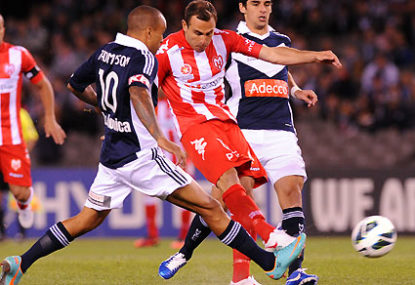It’s a story that just won’t go away. South Melbourne want to buy, Melbourne Heart and the Central Coast aren’t interested in selling, and fans around the country remain divided over the limits of inclusion for certain football clubs in the A-League.
Whether there is merit to South Melbourne joining the A-League is not really the issue here. The owners of Melbourne Heart, to the best of our knowledge, have refused the $3.5 million offer, as well as other offers from overseas consortiums.
That should have been the end of it. But the fact that discussion continues to rage says much about the culture of the game here in Australia.
It’s an issue that clearly transcends the finer details of whether or not South Melbourne are actually granted an A-League license.
Indeed, South Melbourne’s overtures to Melbourne Heart poses a delicate question that must be addressed eventually by both fans and administrators. That is, what is the role of these historic clubs going forward?
Whether you followed the NSL or not, it must be said that these clubs carried the game throughout the last century. Without the effort, ingenuity and passion of these so-called ‘ethnic’ clubs, football is this country would be in a far poorer state.
There is an argument that suggests the strident involvement of migrants ghettoised football, and turned mainstream Australia away from the sport. To some extent, that might be true.
But here’s the kicker – that ghettoisation says more about Australia’s attitude to perceived ‘foreign elements’ than it does about the Italians, Hungarians, Greeks and other European migrants who became involved in the game.
Our insularity is nothing to be proud of, and our collective memory shouldn’t perpetuate outdated stereotypes.
All over the world, football wedges people over issues of class, race, ethnicity or geography. Here, class-based rivalries have developed in rugby league and Australian Rules. But while Australians can handle the Silvertails against the Fibros, nothing strikes fear into our hearts more than ‘ethnic’ tensions.
While there were a few sporadic moments of violence over the course of the competition’s history, we too often remember the NSL for its perceived ‘ethnic’ problems. But this is looking at the issue backwards.
That mainstream Australia so readily cast the game aside as ‘wogball’ is sadly telling.
It won’t be a popular argument. We Australians hate being told about our own history of racism and xenophobia.
Nothing riles the Australian character more than being forced to remember the difficult bits of our own past. It’s far easier to just blame the victim.
And so we do. Ethnics forced us to ignore the football, ethnics didn’t want us to be involved in their clubs, ethnics were too busy chanting fascist slogans at each other, or fighting over the sovereignty of a piece of land thousands of miles away, then to get on with the job of trying to be like us.
Attitudes and culture, it seems, take far longer to change than public policy. The sceptre of assimilation has continued long after the introduction of multiculturalism during the late 1960s and early 1970s.
These days, it’s often said that football truly represents Australia. It’s put forward by the round-ball evangelists, but like all slogans, it’s light on detail.
The truth is that football can be particularly illustrative of Australia – but not always for the most positive reasons.
Which brings us to the present day. After several years of licking their wounds, many of the old NSL clubs are getting on with the task of making sure that their clubs remain conveyor belts of talent.
As we speak, the final touches are being put on a new artificial pitch at Edensor Park, while work will soon begin on a new artificial pitch and stadium upgrade at Lambert Park in Leichhardt.
The launch of the National Premier Leagues has energised the lower tiers of football in Australia, and hopes are high at many State League clubs.
There was plenty of excited chatter about the prospects of promotion and relegation earlier this year, and now the Trojan horse claims it’s packed and ready to enter the A-League.
But are they wanted? Currently, there isn’t a way in, with no licenses available and expansion put on the back-burner by the FFA.
More importantly, there are very few, if any, State League clubs that could actually make the step up to A-League, considering the huge costs involved in operating a successful franchise.
Indeed, it was just as much cost as it was ethnicity which ostracised NSL clubs in the early days of the A-League.
Apart from the privately owned Perth Glory and Adelaide United, few could quickly and easily raise the necessary funds. As Michael Lynch commented in 2009,
“Most of them lacked the sufficient capital to take the sport to the next level. Their contribution was vital – but to move on, the game had to move beyond these boundaries.”
But what happens if South Melbourne, or Marconi, or any other club can afford to compete? What limits are we going to set on their aspirations, and why?
Consensus is unlikely to be reached any time soon. The squabbles will continue. Watch them closely. Terms like ‘multiculturalism’, ‘integration’, ‘racism’, ‘community’ and ‘nationalism’ will continue to be raised, both to promote and denigrate South Melbourne’s cause.
Few other sports in Australia are this fragmented over such emotive issues. It might not always be pretty, but it’s one of the reasons why football is such a fascinating game.





























































































